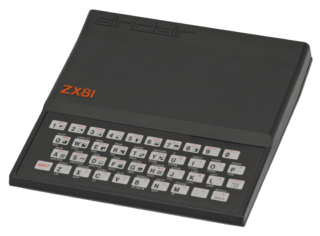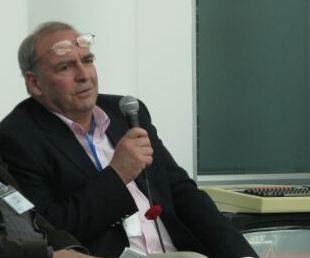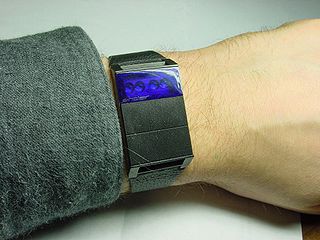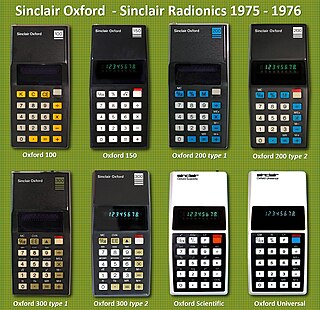
The ZX81 is a home computer that was produced by Sinclair Research and manufactured in Dundee, Scotland, by Timex Corporation. It was launched in the United Kingdom in March 1981 as the successor to Sinclair's ZX80 and designed to be a low-cost introduction to home computing for the general public. It was hugely successful; more than 1.5 million units were sold. In the United States it was initially sold as the ZX-81 under licence by Timex. Timex later produced its own versions of the ZX81: the Timex Sinclair 1000 and Timex Sinclair 1500. Unauthorized ZX81 clones were produced in several countries.

Sir Clive Marles Sinclair was an English entrepreneur and inventor, best known for being a pioneer in the computing industry and also as the founder of several companies that developed consumer electronics in the 1970s and early 1980s.

The Sinclair Scientific was a 12-function, pocket-sized scientific calculator introduced in 1974, dramatically undercutting in price other calculators available at the time. The Sinclair Scientific Programmable, released a year later, was advertised as the first budget programmable calculator.
Sinclair Radionics Ltd was a company founded by Sir Clive Sinclair in Cambridge, England which developed hi-fi products, radios, calculators and scientific instruments.

Christopher Curry is a British businessman and the co-founder of Acorn Computers, with Hermann Hauser and Andy Hopper. He became a millionaire as a result of Acorn's success.
The National Enterprise Board (NEB) was a United Kingdom government body. It was set up in 1975 by the Labour government of Harold Wilson, to support the government's interventionist approach to industry. In 1981 the Conservative government of Margaret Thatcher, combined the NEB with the National Research Development Corporation (NRDC) to form the British Technology Group.
Sinclair Research Ltd is a British consumer electronics company founded by Clive Sinclair in Cambridge in the 1970s. In 1980, the company entered the home computer market with the ZX80 at £99.95, at that time the cheapest personal computer for sale in the United Kingdom. A year later, the ZX81 became available through retailers, introducing home computing to a generation, with more that 1.5 million sold. In 1982 the ZX Spectrum was released, becoming the UK's best selling computer, and competing aggressively against Commodore and Amstrad.

The Grundy NewBrain was a line of microcomputers launched in 1982 by Grundy Business Systems Ltd of Teddington and Cambridge, England. A contemporary of the ZX80 and BBC Micro, the NewBrain was mostly used in business settings. It is notable for its chicklet keyboard and models that featured a one-line display, allowing them to be used as a portable computer, in addition to television output. Another unique feature of the system was NewBrain BASIC, a BASIC programming language that featured an on-the-fly compiler.

The Sinclair Executive was the world's first "slimline" pocket calculator, and the first to be produced by Clive Sinclair's company Sinclair Radionics. Introduced in 1972, the calculator was produced in at least two versions with different keyboard markings; a variant called the Sinclair Executive Memory was introduced in 1973.
Jim Westwood is the former chief engineer who worked at Sinclair Research Ltd in the 1980s, starting at the company in 1963. Westwood was the technical mastermind behind many of Sinclair's products and worked there for more than twenty years.

The Black Watch is an electronic wristwatch launched in September 1975 by Sinclair Radionics. It cost £24.95 ready-built, but was also available for £17.95, as a kit. These prices are equivalent to around £230 and £160 respectively in 2023, when adjusted for inflation.
Nigel Searle is the former managing director of Sinclair Research Ltd, and one of the company's longest-serving employees. He joined Sinclair Radionics in 1973, and for most of the 1970s, Searle worked for Sinclair in the United States to promote the company's calculators and other products. In 1977, with Sinclair in financial trouble, Searle left the company. He rejoined in 1979 when Sir Clive Sinclair formed Science of Cambridge and continued to work from the US, successfully promoting the ZX80 and ZX81 personal computers. In spring 1982, he moved back to the United Kingdom as Sinclair's managing director, a post he retained until 1986 when Amstrad took over the company's computer business.

The Sinclair Sovereign was a high-end calculator introduced by Clive Sinclair's company Sinclair Radionics in 1976. It was an attempt to escape from the unprofitable low end of the market, and one of the last calculators Sinclair produced. Made with a case of pressed steel that a variety of finishes, it cost between £30 and £60 at a time when other calculators could be purchased for under £5. A number of factors meant that the Sovereign was not a commercial success, including the cost, high import levies on components, competition from cheaper calculators manufactured abroad, and the development of more power-efficient designs using liquid-crystal displays. Though it came with a five-year guarantee, issues such as short battery life limited its usefulness. The company moved on to producing computers soon afterwards.

Sinclair Oxford was a range of low-cost scientific calculators manufactured and sold by Sinclair Radionics in England from 1975 until 1976.

The MK14 was a computer kit sold by Science of Cambridge of the United Kingdom, first introduced in 1977 for £39.95. The price was very low for a complete computer system at the time, and Science of Cambridge eventually sold over fifteen thousand kits.

The Sinclair Cambridge was a pocket-sized calculator introduced in August 1973 by Sinclair Radionics. It was available both in kit form to be assembled by the purchaser, or assembled prior to purchase. The range ultimately comprised seven models, the original "four-function" Cambridge – which carried out the four basic mathematical functions of addition, subtraction, multiplication, and division – being followed by the Cambridge Scientific, Cambridge Memory, two versions of Cambridge Memory %, Cambridge Scientific Programmable and Cambridge Universal.

The Sinclair President is a calculator released by Sinclair Radionics in early 1978. There were two models, the President and the President Scientific. They were among the last calculators produced by Sinclair, and their large size was in contrast to the smaller, earlier models, like the Sinclair Executive, which made the company famous. The President models were related to the Sporting Life SETTLER, a calculator designed specifically for betting shops.

The Bell Punch Company was a British company manufacturing a variety of business machines, most notably several generations of public transport ticket machines and the world's first desktop electronic calculator, the Sumlock ANITA.
The Sinclair Wrist Calculator was a wrist-worn calculator produced by Sinclair Instrument and introduced in 1977.













